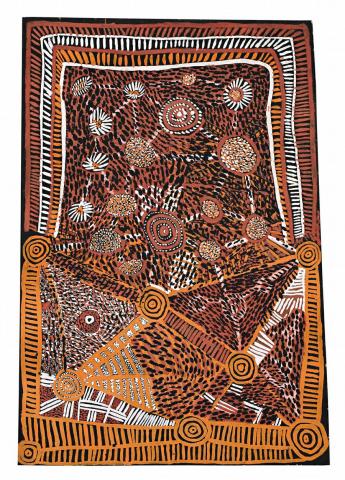MY COUNTRY (HOMELAND) BUSH TUCKER STORY, 1972
TIMMY PAYUNGKA TJAPANGATI
synthetic polymer powder paint and PVA on composition board
46.0 x 31.0 cm
Painted in early 1972 at Papunya, Northern Territory
Stuart Art Centre, Alice Springs (painting 47, consignment 12)
Private collection, South Australia.
This painting is accompanied by documentation from Stuart Art Centre, Alice Springs (catalogue number 12047)
Bardon, G., and Bardon, J., Papunya, A Place Made After the Story: The Beginnings of the Western Desert Painting Movement, The Miegunyah Press, Melbourne, 2004, p. 75 and p. 427 for an illustration of the original field notes and drawing by Geoffrey Bardon. The annotated field notes depict the pattern variation for trees, wild potato, bush banana and black seeds for damper and other bush tucker. Bardon notes that “This drawing shows a Pintupi Dreaming of bush tucker bounty in good season. The painting has a frame like boundary of a foraging journey, linked patterns emphasise a tree pattern and other motifs. The emphatic dotting is for black seed damper where a celebration is being discussed.”
For an extensive discussion of the artist's early paintings see Bardon and Bardon, 2004; Perkins, H. and Fink, H., (eds), Papunya Tula:Genesis and Genius, Art Gallery of New South Wales in association with Papunya Tula Artists, Sydney, 2000; Myers, F. R., Painting Culture: The Making of an Aboriginal High Art, Duke University Press, Durham and London, 2002, and Caruana, W., Aboriginal Art, World of Art Series, Thames and Hudson, London and New York, 2003
From the surviving field notes and text in Bardon and Bardon 2004, itis clear that this painting depicting a Bush Tucker story was untraced and believed lost. Geoffrey Bardon records that he believed that all Bush Tucker stories are either part of or imply a ceremony. 'These paintings, he believes, give emphasis to the kind of food being sought or celebrated after being found or killed, the Bush Tucker Stories most often were stories able to be seen by anyone including children.' They are about the totemic qualities of the food and its glorification and no tabout the roles of ceremonial men.1
Timmy Payungka Tjapangati was born at Parayilpil, an important claypan site where people gathered after seasonal rains to perform ceremonies. During his childhood Tjapangati's family moved across the country from Haasts Bluff, where they sought rations such as flour and tea, to their traditional country around the Alec Ross Range which is situated to the west of Wilkinkarra (Lake Mackay).
After the death of his father, Tjapangati's adoptive fathers Arthur Patuta Tjapanangka and Pinta Pinta Tjapanangka bought him south to near Kintore. In 1958 he moved with his wife Margaret Nampitjinpaand their baby son Noel Charlie Tjapanangka to Haasts Bluff but was consequently sent to Warrabri (Alekarenge) settlement for several years after killing a man in Papunya. Importantly, it was whilst at Warrabri that he learnt to speak English, becoming one of the few bilingual people in the area.
Tjapangati was one of the first Pintupi people to relocate to Papunya and was a founding member of Papunya Tula Artists for whom he started painting in 1971. With his language skills Tjapangati was able to act as a translator for Geoffrey Bardon, who referred to as the artist as 'a secret enforcer of Aboriginal law, and his paintings reveal quite authoritative information'. He was a highly regarded ceremonial leader with responsibility for several important ancestral sites.
In 1993, one of the artist's works was illegally copied, along with works by other prominent artists, onto carpets. The resulting court case in 1994 landmarked the first case involving copyright for Aboriginal artists.
1 Bardon G., and Bardon J., Papunya, a Place made After the Story, The beginnings of the Western Desert Painting Movement, The Miegunyah Press, Melbourne, 2004, p. 53 and p. 311
